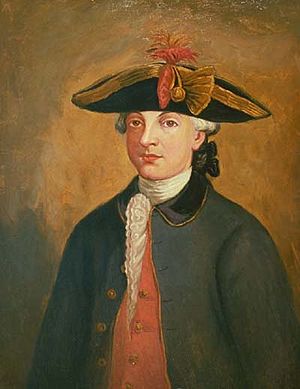Esteban Rodríguez Miró facts for kids
Quick facts for kids
The Most Excellent
Esteban Rodríguez Miró
|
|
|---|---|

Portrait by unknown artist
|
|
| 6th Spanish governor of Louisiana | |
| In office 1785–1791 |
|
| Monarch | Charles III Charles IV |
| Preceded by | Bernardo de Gálvez y Madrid, Count of Gálvez |
| Succeeded by | Francisco Luis Héctor de Carondelet |
| Personal details | |
| Born | 1744 Reus, Catalonia, Spain |
| Died | June 4, 1795 (aged 50–51) Spain |
| Spouse | Marie Céleste Eléonore de Macarty |
| Military service | |
| Allegiance | |
| Branch/service | Spanish Army |
| Years of service | 1760–1795 |
| Rank | Field Marshal |
| Battles/wars | Seven Years' War American Revolutionary War War of the Pyrenees |
Esteban Rodríguez Miró y Sabater (1744 – June 4, 1795) was an important Spanish army officer. He was also known as Esteban Miro or Estevan Miro. He served as the governor of the Spanish provinces of Louisiana and Florida in America. Miró was well-liked by many people. This was especially true because he quickly helped the city of New Orleans after a huge fire in 1788.
Contents
Early Life and Military Career
Esteban Miró was born in Reus, a city in Catalonia, Spain, in 1744. His parents were Francisco Miró and Marian de Miró y Sabater. He joined the military in 1760 during the Seven Years' War.
Around 1765, he moved to Mexico and became a lieutenant. In the 1770s, he went back to Spain for more military training. Then, in 1778, he was sent to Louisiana.
Governor of Louisiana
In 1779, during the American Revolutionary War, Miró joined forces with Bernardo de Gálvez. They fought against the British in West Florida. Gálvez made Miró the acting Governor of Louisiana (New Spain) on January 20, 1782.
Miró officially became the governor on December 16, 1785. Spain had gained control of Louisiana from France in 1763. This happened after France lost the Seven Years' War to Great Britain.
Border Disputes with the U.S.
After the American Revolutionary War, Miró played a key role in a disagreement between Spain and the United States. This dispute was about the northern border of West Florida. Under Spanish rule, the border was at 31 degrees north latitude.
In 1763, the British took control of West Florida. They moved the northern border further north. In 1783, Britain recognized Spain's control of West Florida. However, they did not clearly state the northern border.
In a separate treaty with the U.S., Britain said the southern border was 31 degrees north. Spain claimed the larger British West Florida area. The U.S. wanted the older, smaller border.
Mississippi River Trade Issues
In 1784, the Spanish government closed the lower Mississippi River to American ships. This caused a lot of worry and anger among settlers in Kentucky and Tennessee. These settlers relied on the river to trade their goods. The port of New Orleans was very important for them.
The settlers were angry at Spain, but also at the U.S. government. They felt the U.S. was not doing enough to protect their trading rights. Some people in Kentucky even thought about becoming an independent country.
Helping New Orleans Rebuild
In March 1788, a huge fire, known as the Good Friday fire, destroyed almost all of New Orleans. Miró quickly helped the city. He provided tents for people who lost their homes. He brought in food from warehouses.
Miró also sent ships to Philadelphia to ask for help. He temporarily removed Spanish rules that limited trade in the city. New Orleans was rebuilt with stronger, more fire-resistant buildings. These new buildings used brick, plaster, and ceramic tile roofs. The Saint Louis Cathedral was one of the new buildings constructed under his leadership.
Return to Spain
Miró finished his time as governor at the end of 1791. He returned to Spain to work in the Ministry of War. From 1793 to 1795, he served as a Field Marshal in a war against the French Republic. He passed away from natural causes in June 1795 while at the battlefront during the War of the Pyrenees.
Legacy and Honors
Miró is remembered for several things. In 1788, North Carolina created a judicial district called the Mero District. This area is now around Nashville, Tennessee. It was named after Miró, but the name was misspelled.
In Louisiana, many people remember Miró for preventing the Inquisition from being established there. The Inquisition was a powerful religious court. Miró believed in encouraging more people to settle in Louisiana. This included requiring public practice of Catholicism, but he allowed private worship.
- Miro Street in New Orleans is named in his honor.
- General James Wilkinson named the present Mero Street in Frankfort, Kentucky, after Governor Miró.
- In 1796, when the State of Tennessee was created, half of it was named the Mero District after Miró. This name was used until at least 1807.
Personal Life
Esteban Miró married Marie Céleste Eléonore de Macarty. She was a cousin of Augustin de Macarty, who later became the Mayor of New Orleans.
See also
 In Spanish: Esteban Rodríguez Miró para niños
In Spanish: Esteban Rodríguez Miró para niños

